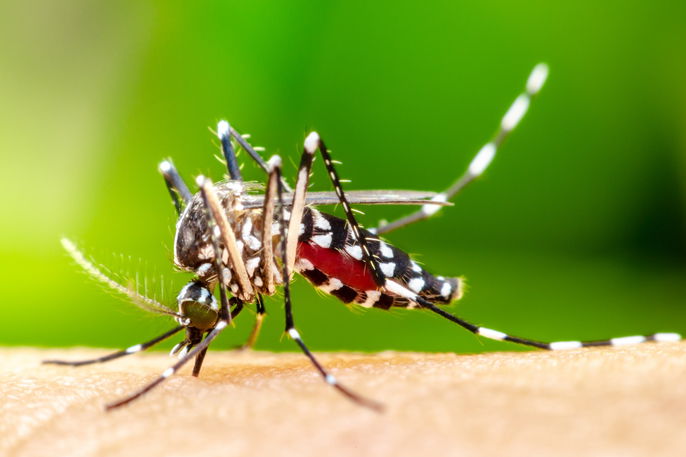The Aedes aegypti mosquito is responsible for transmitting the dengue virus (serotypes DENV-1, 2, 3 or 4,) as well as the ZIKV virus that causes Zika infections or the alphavirus of the Togavirus family that causes Chikungunya. This mosquito can also transmit yellow fever.
The Aedes aegypti mosquito can be identified through characteristics such as white stripes on its body and legs, and clear wings. It is small, measuring approximately 0.5 to 1 cm, and is also silent, as it does not make any noise, like a mosquito.
It is important to avoid Aedes aegypti mosquitoes by preventing the accumulation of stagnant water in containers like cups, tires, bottle caps or plant pots.

What does it look like?
The Aedes aegypti mosquito has the following characteristics:
- Narrow, black body
- White stripes on the abdomen, thorax and head
- Transparent wings
- Three pairs of dark legs with white stripes
- Size between 0.5 and 1 cm
- Low flight, no more than 1 meter above the ground.
Aedes aegypti mosquitoes does not like heat and, therefore, during the hottest times of the day, it hides in the shade or indoor environments. This mosquito is more prevalent in the summer, so you are advised to apply repellents as needed, use insecticide in the house or put mosquito nets on doors and windows.
Where do they bite?
Aedes aegypti mosquitoes usually attack the legs, ankles or feet and its bite is generally painless and does not itch.
Dengue mosquito bites usually occur during the day, especially in the early morning or late afternoon. However, they can also bite at night.
What dengue bites look like?
Dengue mosquitoes do not cause the usual symptoms like itching, redness, pain or swelling that can occur with other mosquito bites.
This is because the saliva of the female Aedes aegypti mosquito contains anesthetic and anticoagulant substances, which is why you may not feel bites when they occur.
Also recommended: Common Dengue Symptoms: Classic & Hemorrhagic tuasaude.com/en/dengue-symptomsCan you get bitten and not catch dengue?
It is possible to be bitten by Aedes aegypti mosquitoes and not catch dengue fever if the mosquito is not infected with the dengue virus.
For dengue fever to be transmitted, the female Aedes aegypti mosquito needs to bite someone who has dengue fever to acquire one of the virus serotypes. This virus multiplies for 10 to 14 days in the mosquito, which can then be transmitted to another person with a mosquito bite.
Only female mosquitoes will bite, as they require blood for its eggs to mature. Female Aedes aegypti mosquitoes will then lay their eggs in clean, still water, where they continue their life cycle.
Aedes aegypti life cycle
The life cycle of Aedes aegypti mosquitoes starts off in still water, where it an egg matures into a larva and then a pupa and later a mosquito. The mosquito then travels to land, where it is ready to reproduce.
The phases of the lifestyle are defined by the following characteristics:
- Eggs: They can remain inactive for up to 8 months above the water line, even in a dry place and in extreme cold. They will wait for ideal conditions, like heat and still water, to transform into a larva.
- Larva: It lives in the water, feeds off of protozoa, bacteria and fungi present in the water for 5 days until it becomes a pupa.
- Pupa: It lives in water where it continues to develop, and becomes an adult mosquito in 2-3 days;
- Adult mosquito: It is ready to fly away from the water and reproduce. It must first feed off of human or animal blood, at which point the transmission of diseases occurs.
The Aedes aegypti mosquito takes an average of 3-10 days to develop and lives for approximately 1 month. The female mosquito can produce 3,000 eggs per day throughout its reproductive cycle.
Preventing bites
To prevent dengue mosquito bites, it is important to avoid having containers that can collect stagnant water, like lids, tires, vases or bottles. Some tips include:
- Keep water tanks closed with a lid;
- Clean out any gutters, removing leaves, branches and other objects that can block the passage of water;
- Do not let rainwater accumulate on the roof;
- Wash tanks that are used to store water weekly with a brush and soap;
- Keep barrels and water barrels tightly covered;
- Fill vase saucers with sand;
- Wash vases that hold aquatic plants once a week using a brush and soap;
- Store empty bottles upside down;
- Dispose of any old tires to local disposal facilities or store them in a way that protects them from the rain;
- Store the trash in closed bags and close bags can tightly.
Another way to prevent the development of the dengue mosquito is to put a natural larvicide in all plant dishes, mixing 2 tablespoons of coffee grounds in 250 ml of water and adding them to the vase. This can be done once a week.
Also recommended: Dengue Treatment (Classic & Hemorrhagic) tuasaude.com/en/dengue-treatment





























